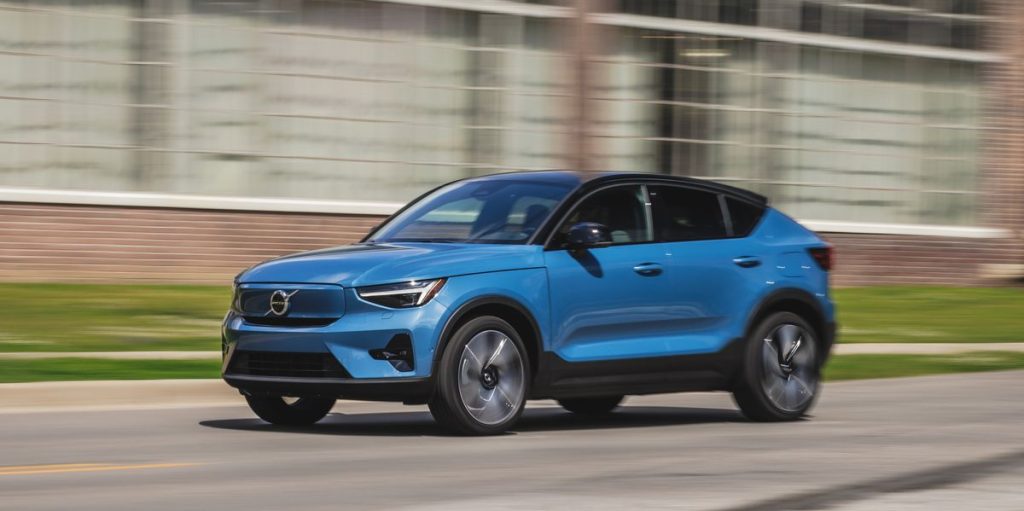Tested: 2022 Volvo C40 Recharge Leans on Style

UPDATE 7/12/22: This review has been updated with test results.
Automakers are understandably anxious not to let crossovers succumb to the miasma that doomed wagons and minivans. Call it the stink of being square, which turned those body styles into icons of the grocery-store parking lot. Luckily for carmakers, injecting insouciance into a people hauler seems to require nothing more than adding some degree of declination between the B-pillar and rear fascia. That’s how Audi creates its crossover Sportbacks, Mercedes and Porsche their crossover coupes, and BMW its even-numbered SUVs.
Volvo has joined that Germanic party with the C40 Recharge. The C still stands for “crossover,” the rake in the roof just making this the more dashing counterpart to the traditionally Swedish XC40 Recharge. The C40 Recharge sits on the same Compact Modular Architecture as the XC40 (said architecture also underpins the sister-brand Polestar 2). The C40 Recharge is also driven by the same dual-motor, all-electric powertrain with 402 horsepower and 486 pound-feet of torque and juiced by a battery with the same nominal 78.0-kWh capacity, 75.0 kWh of it usable.
Michael SimariCar and Driver
There are entries in the gains and losses columns when comparing the C40 Recharge and the XC40 Recharge. In the C40 losses column, the roof sits 2.2 inches lower than that of the XC40, and rear-seat headroom is down by 1.6 inches, although there’s no issue fitting a five-foot-11 frame, with plenty of room to crane the neck. Thanks to the sloping roofline, the luggage space behind the second row takes the obvious hit and is down three cubes (17 to 20) compared with the XC40 Recharge.
And then there’s the back glass, tabbed for a gain and a loss. Volvo claims that the aerodynamic work the designers did aft of the B-pillar, from the roof winglets that cover the liftgate hinges to the rear spoiler, extended range by 6 percent. A software update to the 2022 XC40 Recharge increased last year’s EPA-rated 208-mile range to 223, so the C40’s 226-mile EPA range figure doesn’t make the impact it could have. We managed to cover 200 miles on our 75-mph highway route, though, 20 miles more than the XC40 Recharge.
Michael SimariCar and Driver
However, the work astern put such a steep rake in the hatch that the rear window presents the effective height of a shoebox. Looking in the rearview mirror shows the upper or lower half of a car behind, but not both. The best view of what’s behind is in the side mirrors.
HIGHS: Contemporary Swedish style, enjoyably quick, upscale interior trappings.
The rest of the C40 Recharge emphasizes Volvo’s move into an increasingly eco-conscious and digital future. There will be no internal-combustion version of the C40 Recharge, with the company turning its gaze to 2030, when it aims to sell only EVs.
Michael SimariCar and Driver
The cabin makes the grade as premium, albeit a somber premium. The C40’s leather-free cabin comes exclusively in black in the U.S. market. The backlit abstract topographical map of Sweden’s Abisko National Park on the dash and door panels is a fancy touch. Depending on the car’s exterior color, the seating, upholstered in Microtech and another synthetic with a nubuck look, can be offset with Fjord Blue carpeting made from recycled plastic.
Like with the XC40, Volvo plans over-the-air updates to add new features and options, and in some technical respects, the C40 is a canvas awaiting a few finishing strokes. The user-experience designers stressed simplicity over ultimate functionality, omitting some of the perks one expects from integrated digital displays. The digital instrument cluster offers just two configurations, one with the two gauges separated by a blank area and the other with a small navigation display between them. There’s no way to see what music is playing without clicking to the audio page on the main screen (that information can’t be called up on the dash screen). In fact, we wished for an ever-present menu bar on the main infotainment screen so we could get to any important page in one touch—the same kind of menu bar the Android Auto app has, but that this take on the Android Automotive OS does not. And the left and right arrows on the steering wheel’s left spoke don’t do anything yet. Jonas Engström, head of strategy and business ownership, tells us functionality for them is on the way.
Michael SimariCar and Driver
There’s a new range-extending function that acts like an Eco mode. We’re told that for now it will affect only climate-control operation, but it could expand to tweak other systems that siphon energy from the battery. And there are new pixel headlights composed of 84 LEDs, but their dynamic light patterns aren’t yet available in the U.S.
It takes a few starts and stops to get used to having no start/stop button. Once on the go, the C40 Recharge drives much like its twin. The C40 sprints to 60 mph in the same 4.3 seconds that it took the last XC40 Recharge we tested, with the quarter-mile passing in an identical 12.9 seconds at 108 mph. The dampers do a mostly fine job of keeping 4763 pounds of EV poised as it motors down the road.
LOWS: Minimalist infotainment functionality, less real-world range than the XC40 Recharge, reduced rear-seat headroom and cargo capacity.
Michael SimariCar and Driver
There are two settings for one-pedal driving, on or off. When on at speeds below 31 mph, stout regen braking slows the C40 by 0.22 g (that’s cut in half in travel above 31 mph). In dense traffic, it’s a perfect city aid.
The C40 lost its grace around town only when encountering sharp-edged objects like aggressive speed bumps, railroad tracks, and potholed tarmac—the same as we experienced in the XC40 Recharge. Lacking an internal-combustion engine as a masking agent, the suspension sends impacts from the 20-inch wheels vibrating up the steering column and into the seats. Quick changes of direction are also not a forte—at least not until the C40 Recharge is pushed hard enough to turn the average Volvo owner the same Fjord Blue as our sample car. At the limit, its Pirelli Scorpion Zero All Season tires allowed it to muster just 0.82 g of grip on the skidpad, with stops from 70 mph taking a so-so 178 feet.
Michael SimariCar and Driver
Driven like, well, a Volvo, there’s nothing to disappoint about the ride 99 percent of the time. Volvo tuned the accelerator for progressive, linear response, making it easy to forget how potent this little guy is. On the freeway, a careless stab at the accelerator will push your head into the headrest. With the ability to bolt from 50 to 70 mph in 2.3 seconds, leapfrogging cars ahead and squirting into gaps in traffic is theme-park fun, and the grunt doesn’t tail off at extralegal speeds. The best we could do for high-speed curves for most of our test drive was highway interchanges, but the C40 Recharge was game to arc through them at impressive velocities.
Volvo is only bringing the Ultimate trim to the U.S., priced at $59,845 before tax credits. The figure buys nearly every substantial option, including a panoramic roof, a 360-degree-view camera system, premium audio, Pilot Assist driver-assistance tech, and the Care Package, which includes scheduled services and roadside assistance. That amount also pays for 250 kWh of free charging at Electrify America stations within the first three years. When that’s used up, Volvo will pay for a year of EA’s Pass+ membership, which grants access to discounted charging rates.
Michael SimariCar and Driver
An entry-level 2022 Audi Q4 50 e-tron Sportback comes in about $6000 less expensive, for a lot less power and torque and fewer features, but 15 more miles of estimated range and substantially more luggage room. A comparably equipped version of the Audi, still down on power, tips just past $60,000.
For those seeking an XC40 Recharge with some visual spunk, here it is. That buyer already understands the compromises described and should understand that they will cost more in crossover-coupe form—in this case, $600 more than the XC40 Recharge Ultimate.
That’s the price of not being square. In a Volvo, no less.
A car-lover’s community for ultimate access & unrivaled experiences. JOIN NOW

This content is created and maintained by a third party, and imported onto this page to help users provide their email addresses. You may be able to find more information about this and similar content at piano.io





